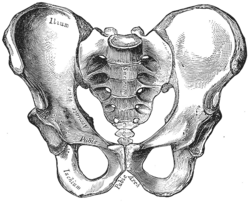| The Human Pelvis | |
|---|---|
 Male type pelvis | |
 Female type pelvis | |
| Details | |
| Nerve | Pelvic splanchnic nerves, superior hypogastric plexus |
| Identifiers | |
| Latin | pelvis |
| MeSH | D010388 |
| TA98 | A01.1.00.017 |
| TA2 | 129 |
| Anatomical terms of bone | |

The pelvis (pl.: pelves or pelvises) is the lower part of an anatomical trunk,[1] between the abdomen and the thighs (sometimes also called pelvic region), together with its embedded skeleton[2] (sometimes also called bony pelvis or pelvic skeleton).
The pelvic region of the trunk includes the bony pelvis, the pelvic cavity (the space enclosed by the bony pelvis), the pelvic floor, below the pelvic cavity, and the perineum, below the pelvic floor.[1] The pelvic skeleton is formed in the area of the back, by the sacrum and the coccyx and anteriorly and to the left and right sides, by a pair of hip bones.
The two hip bones connect the spine with the lower limbs. They are attached to the sacrum posteriorly, connected to each other anteriorly, and joined with the two femurs at the hip joints. The gap enclosed by the bony pelvis, called the pelvic cavity, is the section of the body underneath the abdomen and mainly consists of the reproductive organs and the rectum, while the pelvic floor at the base of the cavity assists in supporting the organs of the abdomen.
In mammals, the bony pelvis has a gap in the middle, significantly larger in females than in males. Their offspring pass through this gap when they are born.
- ^ a b Moore 2014, pp. 357–8.
- ^ "Gray's anatomy". Archived from the original on 2013-10-24. Retrieved 2014-12-20.